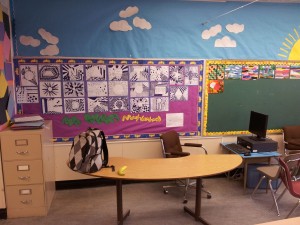Just because I have finished my practicum, finished all of my courses and have a certificate and card stating that I can teach, does not mean that my learning is finished. Learning occurs even once you have signed your contract and are well into your teaching career. My goals for myself once I am finished with this program is to do just that. I believe that it is important to realize that this career is fluid and that teaching and learning go hand in hand and is experienced by both teachers and students.
How would you, as a teacher, handle a troublesome student? There are an abundance of them in any school and you are almost guaranteed to have to deal with them at some point in your teaching career. As a result we are left with a tough decision as to how to handle them. It is easy enough to get angry at troublesome antics and to try to smother the student with your authority. Indeed, there are numerous teachers in the system that employ this tactic. However, is this what is best for the student? I would argue that it is not. We need to try to embody leaders in our school to enact constructive change that will empower students instead of brow beating them into submission. Barth states that, “teachers who lead help to shape their own schools and, thereby, their own destinies as educators” (Barth, 2001, p.445). It is important to remember this as it allows us the agency to take our objectives into our own hands. Problems in teaching, like in life, do not simply disappear. They must be dealt with and if there is a problematic student in a class it is the instructor’s job to solve the issue and help the student succeed.
I argue that we can learn from these students as well. Letting these students slip through the cracks would be terrible. Let us look at these times as a moment to learn and grow as educators. We can test out new strategies and methods for teaching a problem student. These new methods can then be refined and integrated into our regular teaching routine. Likewise, we can use this time to build relationships with the students to help them get a positive experience from being in school. We want to give all students the tools that they will require to learn and continue learning.
In order to help, not only the students who are in my class, but also in my school, I want to work hard to create an environment that supports motivation and positive experiences. Over the course of my practicum I discovered that students were greatly affected by their environment; the environment that I was a part of. Indeed, “…a person’s internal motivation is highly malleable and is closely tied to social reality. Our cultural landscape directly affects whether and how people challenge themselves and others to achieve” (Shenk, 2010, p.121). It is my goal to do everything in my power to help students succeed by creating a productive environment for my students. These environment will change a little from year to year as well. It is important to be able to adapt to these needs. What one student needs may not be productive for another. As we become more experienced, we will learn and gain an increasing number of strategies to use for our students. If we can remain flexible and adapt to the needs of our students, we can create and maintain a productive learning environment for them which will help facilitate their learning needs.

This was my class workstation. I continually tried to maintain a positive atmosphere here to contribute to the overall atmosphere of the class.
References
Barth, R. S. (2001). Teacher leader. Phi Delta Kappan, 82(6), 443-449. Retrieved from
http://www.jstor.org/stable/20439932.
Shenk, D. (2010). The genius in all of us: Why everything you have been told about genetics,
talent, and IQ is wrong. Toronto: Random House of Canada Limited.